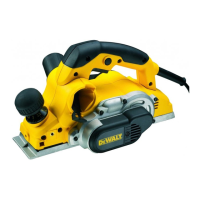22
ENGLISH
Example:
2018 XX XX
Year of Manufacture
Description (Fig. A)
WARNING: Never modify the power tool or any part of it.
Damage or personal injury couldresult.
1
On/off switch
2
Lock-off button
3
Shavings discharge outlet
4
Planing depth adjustment knob/front handle
5
Planing depth graduation
6
Parking shoe
Intended Use
Your D26500 planer has been designed for professional planing
ofwood.
DO NOT use under wet conditions or in the presence of
flammable liquids orgases.
These planers are professional power tools.
DO NOT let children come into contact with the tool.
Supervision is required when inexperienced operators use
thistool.
• Young children and the infirm. This appliance is not
intended for use by young children or infirm persons
without supervision.
• This product is not intended for use by persons (including
children) suffering from diminished physical, sensory or
mental abilities; lack of experience, knowledge or skills
unless they are supervised by a person responsible for their
safety. Children should never be left alone with thisproduct.
ASSEMBLY AND ADJUSTMENTS
WARNING: To reduce the risk of serious personal
injury, turn tool off and disconnect tool from power
source before making any adjustments or removing/
installing attachments or accessories. Be sure the
trigger switch is in the OFF position. An accidental start-up
can cause injury.
Replacing the Cutting Blades (Fig. B)
The cutting blades fitted on this tool are reversible. If both sides
are worn, the cutting blades have to bereplaced.
WARNING: Always replace the bladessimultaneously.
1. Carefully rotate the cutterhead
7
until the first blade
becomesvisible.
2. Loosen the bolts
8
using the spannersupplied.
3. Pull up the side guard
9
.
4. Slide the blade
10
out of itsholder.
5. Reverse the blade or replaceit.
6. Slide the blade into the holder. At the rebating side (i.e. the
side where the side guard is mounted), the cutting blade
must be flush with the planingshoe.
7. Adjust the blade as describedbelow.
8. Tighten the bolts
8
.
Repeat as for the otherblade.
Adjusting the Blades (Fig. B)
1. Ensure the depth of cut is set at 0mm.
2. Check the position of the blade
10
at both ends. Use a flat
object as a level across the planingshoe.
3. The tip of the blade must be flush with the planing
shoesurface.
4. If adjustment is required, proceed as follows:
Turn each adjusting screw
11
in or out as necessary until
the blade tip coincides with the planingshoe.
Adjusting the Depth of Cut (Fig. A)
Turn the planing depth adjustment knob
4
. One revolution of
the adjustment knob equals a 4.0 mm change indepth.
One graduation corresponds to a depth of cut of 0.1mm.
Attaching, Removing and Adjusting the
Parallel Fence (Fig. C)
The parallel fence
12
is used for optimum tool control on
narrow workpieces. The parallel fence can be fitted to either side
of thetool.
1. Assemble the parallel fence
12
in such way that the fence
profile will provide guidance from the front of the tool until
behind thecutterhead.
2. Fit the parallel fence to the threaded hole
13
from
eitherside.
3. Tighten the wing bolt
14
.
To remove the parallel fence, remove the wingbolt.
To Adjust the Parallel Fence
1. Loosen the wing nut
15
.
2. Adjust the fence so that there will be just enough area of the
cutterhead left to cut the workpiecesurface.
3. Tighten the wingnut.
Attaching, Removing and Adjusting the
Rebating Depth Stop (Fig. D)
1. Install the depth stop
16
.
2. Tighten the wing bolt
17
at the desired height in the
threaded hole
13
using thescale.
3. To remove the depth stop, remove the wingbolt.
Fitting and Removing the Shavings Ejector
(Fig. E, F)
The tool can be used for both left-hand and right-hand side
shavingsdischarge.
For right-hand side shavings discharge (Fig.E), the tool
can be used with or without the ejector.
1. Push the ejector
18
into the right-hand side shavings
discharge outlet
3
until it clicks inplace.

